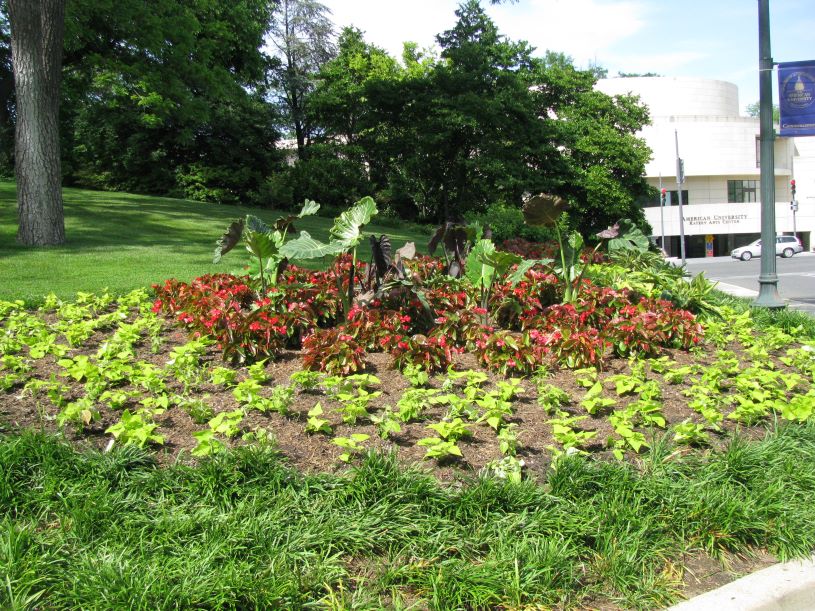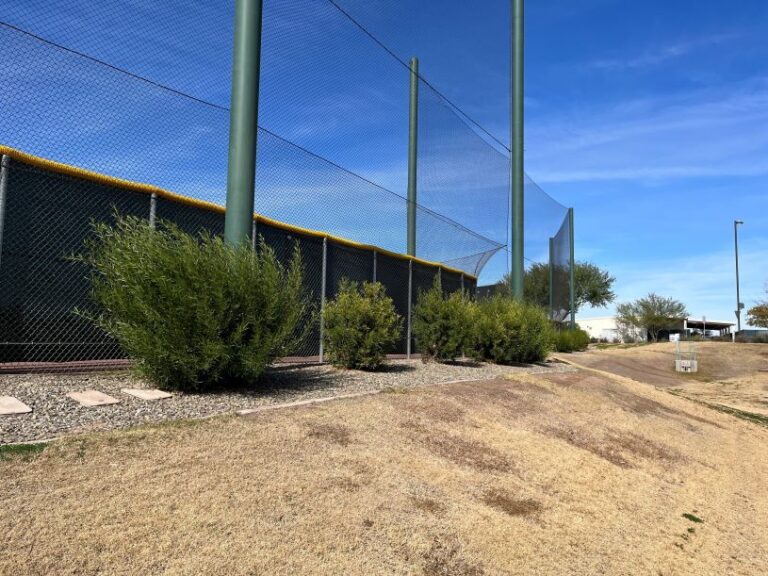By John C. Fech
Chances are good that taking care of tulips, periwinkle and crabapples isn’t the highest priority on the sports field manager’s to-do list on any given day. However, in addition to athletic fields, many field managers are tasked with care of the campus grounds or parks facilities.
So, if your hair is on fire with Poa, anthracnose and grubs, the tendency is to inwardly say, “Who cares about trees, flowers and shrubs?” However, making good choices up front before planting, and spending a little time making sure that these plants are attractive and in good shape will ensure that their management details can be crossed off the list – providing focused attention to various turf issues instead.
Site assessment/site analysis
Choosing wisely starts with a good understanding of the site itself and its suitability for ornamentals. Any landscape, regardless of function, can be improved through site assessment and site analysis. Though more helpful when conducted before installation of plant materials, considering all aspects of the site is truly an underutilized and immensely advantageous process.
What’s an assessment and an analysis of the site? An assessment is a snapshot of the status of each plant – the raw information. An analysis is the companion piece – the diagnosis, value judgment and recommendation for the individual specimens as they exist on the day of the inspection.
The main function of the assessment is to make specific notes and document various observations about the condition of the plants, such as “poor growth this year,” “decay in trunk” and “overgrowing the sidewalk.” It helps the process of keeping each field or group of plants surrounding a building separate so that they don’t get mixed up with other fields or groups. A clipboard and notebook paper or iPad/tablet work really well for assessments.
After assessing/documenting, it’s time to determine what caused the malady or concern and decide how serious it is. For example, a shrub might be struggling because when the soil near the crown is probed the blade of the screwdriver or metal stake is muddy when it is pulled out, leading to an effort to find the source of the possible overwatering. The note of “pale leaves and stunted growth” could lead to a suggestion of auditing the nearby sprinkler system, looking for leaks, incorrect runtimes and overspray. Digging a hole to look at the roots would also be a possible action step.
The process of assessment and analysis can seem to be negative or downright depressing, yet it’s really an opportunity to replace moderately or severely disease-susceptible or poorly sited specimens. After all, if a plant dies from root rot, it creates a void in the landscape that must be filled with better-adapted plant material. Consulting with a landscape designer, landscape architect, ISA Certified Arborist or local land grant university extension professional will provide valuable information throughout this process.
What’s needed?
Choosing wisely also begs the question of what is needed around sports fields or on the campus grounds. Non-turf plants can provide quite a variety of functional and aesthetic benefits, often identifying possible solutions through general groups of plant materials. General groups provide the sweet spot between the “everything is on the table” and “ultra-specific” when choosing plants. They also allow for a good match-up, considering soil type, sun exposure, disease pressure, size allotment and adjoining hardscape. Avoid choosing a particular plant until all of these have been fully considered.
If sun/heat relief is needed for players and spectators, a shade tree might be a good answer. Refreshment stands and bleachers are often well utilized when the space is welcoming instead of one that requires the squinting of eyes and the use of a fan to create a breeze.
If the need is to reduce mowing, groundcovers might be a good choice. They’re available in a variety of colors, heights and textures in addition to evergreen and deciduous. Some out-of-play areas can be converted to no-maintenance zones with wildflowers or no-mow fescues that replace fine turfgrasses such as bermuda and Kentucky bluegrass.
If the area tends to be monochromatic, spring and summer flowering bulbs with a good bloom sequence in mind can provide near-season-long color. Other plants such as coneflowers and shrub roses can also provide desirable visual appeal.
If narrow strips of turf are present, the choice might be to replace them with perennials in these locations. Perennials usually tolerate the heat island effect that tends to be present with narrow strips, and they don’t need to be aerated, mowed or overseeded; they usually require less fertilizer and water as well.
Slopes always present a challenge for spaces with turfgrass. Replacing it with plants that don’t require mowing adds a big safety improvement. A choice such as a groundcover, shrub or perennial doesn’t mean that the slope is a no-maintenance space, just that it has been reduced. These plants still need monitoring to be sure that soil moisture, weeding and other needs are being taken care of.
Right plant, right place
One of the most used phrases in the green industry over the past 10 to 20 years is “right plant, right place” (RPRP), and for good reason. It’s rock-solid, straight-as-an-arrow, right-on-track guidance. Perhaps the best part of RPRP is that it encourages field managers and landscapers to use a full array of considerations when choosing plants. These RPRP components are just as important as sun/shade preference and eventual height:
- Width – The other side of eventual height is width. It’s commonly overlooked, especially with hedges, small trees and plants installed near hardscapes.
- Disease resistance – Disease resistance equals low maintenance and low cost, which is especially desirable for ornamentals at a sports facility.
- Level of maintenance – High maintenance can be tolerated in high-visibility areas, but other areas can be planted for low maintenance.
- Soil moisture and pH – Choosing plants adapted to various soil components is critical.
- Blooming sequence – It’s great to have something blooming at all times and just takes a little planning.
- Leaf color and texture – Green leaves in spring, summer and fall offer two-for-the-price-of-one benefits.
- Growth habit – Columnar, spreading, pyramidal, etc.
- Native choices – Chances are good that if it’s native, it’s going to survive.
- Hardiness zones – Cold and heat zones sometimes change; choosing wisely takes this into account.
- Slope – Mowing can be tough on a slope; perhaps groundcovers or low-growing shrubs are a better choice.
- Flower/fruit/fragrance – Butterflies are always welcome, but bees can be a real problem, especially for fans and players that are allergic.
- Color – Always a “wow” factor, a 2-3 color scheme is welcome in the sports turf and campus landscape.
- Safety – Landscape debris droppage can be a hindrance and photosynthesis limitation in other situations.

Choose local or national?
Is it best to choose ornamental plants on a national or local basis? The answer is neither; it’s both. The bottom line is the performance of the plant at your facility. National information and marketing sources can help identify species that have appeal and have been selected based on favorable ratings in the RPRP categories, but they must be locally validated with testing and recommendations for plant materials by local horticulturists and from local/regional information sources. Selected sources of plant material information:
- All America Selections
- All America Rose Selections
- Proven Winners
- University websites
- Local botanic gardens and arboretums
Once you find a specific plant that shows promise, use an illustrator tool such as Google Images or Yahoo Image Search to help determine if the features are the ones you’re looking for. For example, if you’ve heard of ‘Mohican’ viburnums, simply go to the image site and type in “Mohican viburnums” in the search box, and voila, hundreds of photos of (you guessed it) Viburnum lantana, spp. ‘Mohican’ will appear.
After information has been gathered from these sources, contact or visit your nearest public botanic garden or arboretum. It’s one thing to see a plant on a web page or in a catalog; it’s quite another to see it/touch it/smell it in person.
Develop a plant palette
As choices are made, evaluated and adjusted, it’s important to create a localized list of go-to plants – sometimes called a plant palette. Such a list can be created and organized in many ways, but for the purpose of a sports field or campus grounds, perhaps the best approach is to start with light requirements, then fill each subcategory with 10-25 plant species choices in each. For example:
Full sun Light shade Medium shade Heavy shade
Small trees Small trees Small trees Small trees
Large shrubs Large shrubs Large shrubs Large shrubs
Small shrubs Small shrubs Small shrubs Small shrubs
Groundcovers Groundcovers Groundcovers Groundcovers
Perennials Perennials Perennials Perennials
Annuals Annuals Annuals Annuals
Don’t stop with five choices for each category or your facility may end up with too many of too few species. This will best serve as a handy guide for choosing plants when you don’t have much time to make your choice.
Proper spacing
Spacing is commonly ignored, but can be primarily responsible for the eventual health and success of an ornamental planting for several reasons. Plants spaced too close together are likely to crowd each other, compete for water and nutrients and create a dense canopy that encourages the development of foliar diseases. Plants spaced too far apart often lack the visual appeal necessary to create an aesthetically pleasing mass.
Proper spacing is also influential in terms of the budget. Because it’s tempting to conveniently forget that small plants grow into big ones, planting for immediate appeal not only creates competition, but it also causes the sports field manager to spend more money on plants than they needed. The proven approach is to read the plant care tag, understand the spacing recommendations and then believe them – or at least use some restraint when the temptation for closer spacing rears its ugly head. Using plant spacing discipline is the key to success when choosing the number of plants to buy and how close together to install them.
John C. Fech is a horticulturist with the University of Nebraska-Lincoln and Certified Arborist with the International Society of Arboriculture. The author of two books and more than 400 popular and trade journal articles, he focuses his time on teaching effective landscape maintenance techniques, water conservation, diagnosing turf and ornamental problems, and encouraging effective bilingual communication in the green industry.


